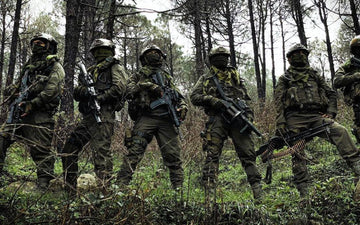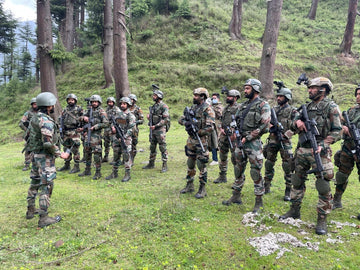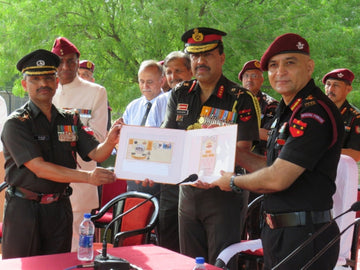Joining the National Security Guard (NSG) Commando Force, colloquially known as the Black Cat Commandos, is a journey that demands not only exceptional physical fitness but also mental fortitude, discipline, and a profound commitment to serving the nation. This elite force plays a critical role in counter-terrorism operations, hostage rescues, and high-risk interventions, making its selection process one of the most rigorous in the Indian Defence landscape. Aspiring candidates must navigate through a well-defined, multi-phased selection and training process that guarantees the readiness of operatives for the challenges they will face.
Historical Context
Established in 1984, the NSG was formed in response to the growing need for a specialized counter-terrorism unit within India. The immediate catalyst for its creation was the need to tackle extreme forms of violence, including hijackings and terrorist activities that posed grave threats to national security. Drawing on international influences, particularly from combat scenarios managed by units such as the British SAS and the American Delta Force, the NSG has evolved into a formidable force, capable of addressing today's most sophisticated threats. Over the decades, the NSG has gained acclaim for its successful operations, demonstrating the high stakes and valuable expertise involved in enlisting and training commandos.
Step-by-Step Process to Join the NSG
Step 1: Join the Armed Forces or CAPF
The journey to becoming an NSG commando begins with a career in the armed forces or the Central Armed Police Forces (CAPF). Candidates have several pathways to enlist, including:
- National Defence Academy (NDA): An esteemed institution for those who aspire to join the Indian Armed Forces, where candidates undergo rigorous training before they are commissioned into various branches of the army.
- Combined Defence Services (CDS): A competitive examination for graduates aiming to join the armed forces as officers, providing another vital route for entry.
- Direct Recruitment: Individuals can join various branches of the Indian Army, Navy, or Air Force, setting the foundation for potential NSG candidacy.
This initial step forms the basis for acquiring the essential military skills and discipline required for successful performance within the NSG framework.
Step 2: Gain Required Experience
Once you have joined the armed forces, gaining practical experience is paramount. The NSG requires:
- For Indian Army Personnel: A mandatory service period of at least three years is stipulated. This tenure ensures that candidates have ample exposure to military protocols and operational readiness.
- For CAPF Candidates: A minimum of five years is expected. This includes experience in various capacities, honing skills that are crucial for counter-terrorism and emergency response.
Experience not only enhances physical abilities but also instills critical decision-making skills and teamwork, all of which are vital during training and operational phases.
Step 3: Meet Eligibility Criteria
NSG commandos must meet stringent eligibility criteria, including:
- Age Limit: Candidates typically must be no older than 35 years at the time of application.
- Physical and Medical Standards: Rigorous health screenings and physical fitness evaluations ensure that only the fittest candidates qualify for the demanding nature of NSG operations.
These standards are crucial in ensuring candidates possess the resilience and stamina required to perform high-stakes missions under extreme stress.
Step 4: Volunteer for NSG Selection
Volunteering for the NSG selection process is an essential step. Interested candidates should:
- Monitor internal postings for opportunities.
- Seek recommendations from superiors based on their performance and skills.
This step not only requires personal initiative but also reflects the candidate's commitment and readiness to serve in one of the most demanding forces.
Step 5: Clear the NSG Selection Process
Once the candidate has volunteered, they must navigate a highly competitive selection process that includes multiple phases:
- Pre-Selection: Initial assessments involve physical tests—5-kilometer runs, wall scaling among others—and psychological tests to gauge mental toughness.
- Physical Tests and Psychological Assessments: A comprehensive evaluation is performed to ensure candidates possess the necessary physical attributes and mental fortitude for high-pressure situations.
Successfully clearing these stages signals that the candidate possesses the foundational skills and mindset essential for the next phases of training and operational readiness.
Step 6: NSG Training
NSG training is extensive, known for its challenging environments, designed to push candidates beyond their limits. It is divided into three main phases:
-
Basic Training (90 Days):
- Conducted at the NSG training center in Manesar, Haryana, this phase is marked by rigorous physical drills, sharpshooting, and discipline in mental conditioning.
- Candidates undergo dawn runs and martial arts training; sleep becomes a rare comfort as physical toughness is fostered.
-
Qualification Training (3 Months):
- This phase simulates real-life combat scenarios, training commandos to respond effectively in high-stress situations. They undergo rappelling from heights and navigate through difficult terrains during exercises.
-
Advanced Training (9-11 Months):
- Candidates learn specialized skills required for counter-terrorism, including hostage rescue operations, bomb defusal techniques, and urban warfare tactics.
- Some may also receive international training, such as collaborations with elite units overseas, further enhancing their operational capabilities.
This extensive training ensures that NSG commandos are not just physically apt but also mentally agile and tactically proficient.
Step 7: Assignment to NSG Units
Upon successful completion of training, commandos are assigned to various specialized units within the NSG, including:
- Special Action Group (SAG): Primarily composed of personnel from the Indian Army, this unit is frontline responders during counter-terrorism operations.
- Special Ranger Group (SRG): This includes personnel from CAPF and police forces, providing VIP security and supporting SAG in operations.
- Special Composite Group (SCG): These teams are strategically placed in major urban centers like Mumbai, ensuring rapid response capabilities for emergencies.
This system of units allows for a diverse range of operational capabilities and responsiveness across different threat scenarios.
Compensation and Benefits
The commitment to becoming an NSG commando comes with notable financial remuneration and benefits. During the training phase, candidates receive a stipend of approximately ₹18,000, which is enhanced post induction:
- Salary Range: Once inducted, salaries can vary from ₹40,000 to ₹85,000 per month, equivalent to their respective salaries in the parent force.
- Allowances and Benefits: Additional allowances for duty in high-risk situations, healthcare benefits, and housing allowances contribute to an attractive compensation package for commandos.
The financial incentives reflect both the risks involved in the role and the significance of the skills possessed by the commandos.
Service Tenure
Typically, NSG commandos serve a tenure of 3-5 years. This rotational policy allows the organization to maintain a youthful and dynamic workforce, ensuring adaptability and ongoing operational effectiveness. After their term, commandos typically return to their parent forces, bringing back valuable experiences and skills gained during their service.
Challenges and Solutions
The journey to becoming an NSG commando is replete with challenges, with dropout rates soaring from 70% to 80%. This emphasizes the demanding nature of the selection process and the intense physical and psychological challenges faced. Here are some common challenges:
- Physical Fitness: Many candidates struggle to meet the physical benchmarks set during training and selection.
- Mental Resilience: The psychological demands during training can overwhelm candidates, leading to high dropout rates.
Solutions
- Pre-Training Preparation: Candidates should engage in rigorous physical training and mental conditioning well before applying, enhancing their chances of meeting the demands of the selection process.
- Structured Support Systems: Establishing mentorship channels where experienced commandos coach potential recruits could provide moral support and practical insights into overcoming training challenges.
Future Trends and Predictions
In the evolving landscape of counter-terrorism, the NSG is likely to adapt in several ways:
- Enhanced Technological Integration: Future commandos may need to develop proficiency in utilizing advanced technology and surveillance systems, improving their effectiveness during operations.
- Focus on Psychological Training: A greater emphasis on mental health and resilience training may emerge to bolster the psychological endurance of commandos.
- International Collaboration: As global terror threats evolve, the NSG may increasingly engage in joint exercises and training programs with allied nations, enriching their tactical knowledge and operational capabilities.
Conclusion
Joining the NSG Commando Force is more than a career choice; it represents a commitment to serve and protect the nation against formidable threats. The process demands rigorous physical training, unwavering mental strength, and a passion for high-stakes operations. For those who aspire to wear the elite Black Cat insignia, the journey is tough but ultimately rewarding. As prospective candidates prepare for this demanding path, understanding each critical step ensures they are well-equipped to face the challenges ahead. By fostering resilience and determination, future NSG commandos stand ready to uphold the legacy of excellence that defines this prestigious unit.
For those keen on embarking on this journey, it is essential to leverage available resources such as study materials, online courses, and expert guidance through platforms like SSBCrack and SSBCrackExams. As you prepare, remember that the road may be long and challenging, but the rewards of serving your country in such an esteemed capacity are immeasurable. Embrace the challenge, and you may find yourself among India’s elite—the Black Cat Commandos.






Healthy
I want to become NSG commando
I want to become NSG commando
I also want to join Black Command.
I want to join as Black cat commando services.I am working in Cipla.employee I’d 143822.as quality Assurance senior Executive.And now I want to join as Black cat commando force.